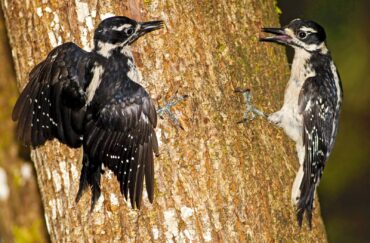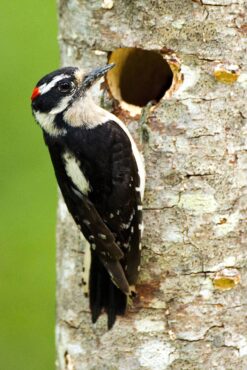
All birds have their place in the ecosystems in which they live. Some are “keystone” species that other creatures rely on, making them a critical component of their respective biomes.
Among the keystone species of birds are woodpeckers. As the name suggests, woodpeckers peck wood. But their pecking has a purpose. They’re excavation experts.
Woodpeckers chisel out nesting cavities in which to raise their young, and these cavities later serve as homes for other cavity-nesting birds and critters. Thus, a forest without woodpeckers would be devoid of multiple other species as well.
There are over 200 known species of woodpeckers in the world today. Sadly, some have gone extinct or are critically endangered due to habitat loss.
Woodpeckers can be found throughout the world, except for Antarctica, Greenland, Iceland, Madagascar, Australia and the Pacific islands. They inhabit tropical, temperate and boreal forests, from dense wilderness to suburban backyards. Woodpeckers even live among Saguaro cacti in the desert Southwest.
Of the 26 species of North American woodpeckers, 22 live in the United States. There are 12 woodpecker species in Washington, five of which are year-round residents of West Sound: downy and hairy woodpecker, red-breasted sapsucker, northern flicker and pileated woodpecker.

Downy and hairy woodpeckers are often confused. Despite their difference in size, they look remarkably similar. Both have black-and-white plumage, with males sporting a red nape. Juveniles have a red cap that fades within a few months.
The easiest way to tell “downies” and “hairies” apart is by size, which is obvious when they’re foraging near each other. A downy measures 6-7 inches from head to tail, while a hairy is longer, 8-9 inches. The downy weighs a mere ounce and the “heavyweight” hairy can weigh up to 3 ounces.
When you spot a lone woodpecker, it can be difficult to tell which species it is based on size alone. It helps to look at the bill. The downy’s bill is short, about half the length of the rest of its head. In contrast, the hairy’s chisel-shaped bill is long and about the same length as its head.
The downy is the smallest woodpecker in North America. It may get bullied from backyard suet feeders by larger woodpeckers, but its small stature has some advantages. Downy woodpeckers are common throughout much of the United States and Canada. In winter, they sometimes feed alongside mixed flocks of songbirds.
Weighing as much as a compact disc, the opportunistic downy woodpecker can forage virtually anywhere, including tall weed stalks and the underside of thin tree branches, where it searches for insects. Its tiny bill is capable of grabbing insect eggs and grubs from crevices in tree bark.
Downy woodpeckers are found in mixed forests and tend to prefer deciduous trees. Their small bills make them weak excavators, so they often choose the soft wood of dead or dying trees for digging out a 6- to 12-inch-deep nest cavity, which a pair may take up to three weeks to complete. The entrance hole is 1 1/4 inches wide.
The hairy woodpecker is medium-sized, with an extensive range that stretches from Alaska to Panama. Its appearance can vary considerably from north to south. Central American hairies are smaller and have underparts that are light brown instead of white like their larger northern counterparts.
Hairy woodpeckers are less common than their smaller downy cousins. They live in mixed forests, but prefer midelevation areas with mature trees. Because of their larger size, they mostly forage for insects on tree trunks rather than going out on a limb.
The hairy woodpecker is a highly capable excavator. A pair can chisel out a nest chamber 8 to 12 inches deep in a snag or dying section of a live tree in less than two weeks. The entrance hole is 1 1/2 or 2 inches wide.
Downy and hairy woodpeckers supplement their diet with fruit, seeds and tree sap from sapsucker wells. They also visit backyard suet feeders.
Downy and hairy woodpeckers are keystone species of a healthy forest. Since they both hammer out a new nest hole each year, previously dug nests become nurseries for squirrels and cavity-nesting birds such as chickadees, nuthatches, bluebirds and northern pygmy-owls.
Downy and hairy woodpeckers are part of nature’s solution to problem insects, like bark beetles and gypsy moths, which can fatally damage trees. The larvae of these pests provide woodpeckers with tasty feasts.
To protect woodpecker habitat, it’s essential to leave a dead tree as it stands, or shorten it if necessary, rather than fall the entire snag.
Woodpeckers are fascinating birds and important residents of a healthy forest. Downy and hairy woodpeckers frequently cross paths and have unique roles in creating habitat for other species. Similar, yet different, these birds are a delight to have among us.



























